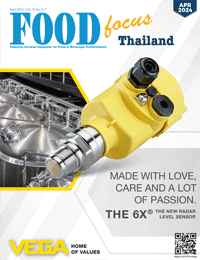การผลิตแมลงบริโภคได้เพื่อเป็นแหล่งอาหารที่ปลอดภัยและยั่งยืน Edible Insect Production as a Source of Safe and Sustainable Food
1441 Views |

การผลิตแมลงบริโภคได้เพื่อเป็นแหล่งอาหารที่ปลอดภัยและยั่งยืน
Edible Insect Production as a Source of Safe and Sustainable Food
By: ผศ.ดร. วศะพร เพรททิเซย์ จันทร์พุฒ
Assist. Prof. Wasaporn Preteseille Chanput, Ph.D.
Department of Food Science and Technology
Faculty of Agro-Industry
Kasetsart University
wasaporn.c@ku.ac.th
มนุษย์มีการบริโภคแมลงตั้งแต่อดีตจนถึงปัจจุบัน ไม่ว่าจะเป็นการบริโภคไข่ ตัวอ่อน ดักแด้ และตัวเต็มวัย ซึ่งแมลงไม่เพียงแต่อุดมไปด้วยกรดไขมันที่จำเป็น แต่ยังประกอบด้วยกรดอะมิโนจำเป็น วิตามิน และแร่ธาตุ การเพาะเลี้ยงแมลงใช้พื้นที่ ทรัพยากรน้ำและอาหารน้อยกว่าการทำฟาร์มปศุสัตว์ทั่วไป ส่งผลให้มีความเป็นมิตรต่อสิ่งแวดล้อม และมีการปลดปล่อยก๊าซเรือนกระจกน้อยลง ดังนั้นการเพาะเลี้ยงแมลงจึงถือเป็นทางเลือกใหม่ที่มีความเป็นไปได้ในการก้าวข้ามปัญหาด้านสิ่งแวดล้อม ถึงแม้ว่าหลายประเทศอาจมองว่าแมลงเป็นแหล่งสะสมของเชื้อโรคและเป็นพาหะนำโรคต่างๆ แต่จากการคาดการณ์ พบว่าแมลงอาจกลายเป็นแหล่งโปรตีนที่มีความสำคัญมากในอนาคต อันเนื่องมาจากจำนวนประชากรโลกที่เพิ่มขึ้นภายในปี พ.ศ. 2593 เป็น 9 พันล้านคน รวมถึงทิศทางความต้องการอาหารที่มีความปลอดภัยและยั่งยืนมีแนวโน้มเพิ่มขึ้นสูงขึ้นถึงร้อยละ 60
ที่มาของการปนเปื้อนจากการเพาะเลี้ยงแมลงสู่ผลิตภัณฑ์
1. อันตรายจากสารเคมี
อันตรายทางเคมีส่วนใหญ่ที่พบในแมลงขึ้นอยู่กับแหล่งที่เลี้ยงแมลงและการปนเปื้อนในอาหารที่ใช้เลี้ยง ซึ่งอันตรายเหล่านี้สามารถควบคุมได้โดยใช้เทคนิคการจัดการฟาร์มที่ดี เนื่องจากสิ่งปนเปื้อนอาจเกิดจากภาชนะ อาหารเลี้ยงที่ใช้เลี้ยง และจากสิ่งแวดล้อม
2. สารพิษจากเชื้อรา
สารพิษจากเชื้อราจัดเป็นสารระดับทุติยภูมิที่ผลิตจากเชื้อราก่อโรคและเชื้อราที่ทำให้อาหารเน่าเสีย โดยพบในอาหารที่ใช้เลี้ยงแมลง สารพิษจากเชื้อรา Fusarium, Aspergillus และ Penicillium สามารถคงอยู่ในลำไส้ของแมลงซึ่งทำให้เกิดปัญหาด้านความปลอดภัยอาหาร เนื่องจากสารพิษเหล่านี้สามารถส่งผลกระทบต่อมนุษย์และสัตว์ทั้งแบบเฉียบพลันและเรื้อรัง
3. สารก่อภูมิแพ้
อาร์โทรพอด (arthropod) หรือกลุ่มสัตว์ขาปล้องมีความสามารถในการก่อภูมิแพ้คล้ายกับสัตว์น้ำที่มีเปลือกแข็ง (crustacean) เนื่องจากมีโปรตีนก่อภูมิแพ้คล้ายกัน เช่น โทรโปไมโอซิน (tropomyosin) อาร์จินีนไคเนส (arginine kinase) กลีเซอรัลดีไฮด์ 3-ฟอสเฟตดีไฮโดรจีเนส (glyceraldehyde 3-phosphate dehydrogenase) และเฮโมไซยานิน (hemocyanin) โดยแมลงอาจก่อให้เกิดอาการแพ้ได้ผ่านการสัมผัส การสูดดม หรือการบริโภค ซึ่งพบว่าตั๊กแตน จิ้งหรีด และดักแด้หนอนไหมสามารถก่อให้เกิดอาการแพ้แบบเฉียบพลัน รวมถึงอาการแพ้ข้ามกับสัตว์จำพวกกุ้ง แมลงสาบ และไรฝุ่นอีกด้วย
Entomophagy has been a part of human diets from prehistoric times to the present day. The eggs, larvae, pupae, and adults of certain insects are not only rich in essential fatty acids but also essential amino acids, vitamins, and minerals. Insect farming requires less land, water, and feed, and produces fewer greenhouse gases, thus offering a potential solution to the environmental challenges posed by conventional animal agriculture. In many cultures, insects are often perceived as dirty, disgusting, or as disease vectors. However, with the world population predicted to reach nine billion by 2050 and the demand for safe and sustainable food expected to increase by approximately 60%, alternative sustainable protein sources like insects are becoming increasingly important.
1. Chemical hazards
Chemical hazards found within insects are mostly dependent on habitat and feed contamination, both of which can be controlled through selected farming techniques. The contaminants may be present in the substrate used, or within the environment.
2. Mycotoxins
Mycotoxins are secondary metabolites produced by pathogenic and food spoilage molds and are often found in the feed substrate upon which the insects are reared. The mycotoxins of Fusarium, Aspergillus, and Penicillium can also be present within the gut of an insect, thus indicating the potential of related food safety issues because these toxins could potentially impose acute and chronic effects on humans and animals.
3. Allergens
Arthropods are related to crustaceans, and therefore, arthropods are recognized sources of induced allergic reactions in humans. Such reactions are often induced by the presence of tropomyosin, arginine kinase, glyceraldehyde 3-phosphate dehydrogenase, and haemocyanin. Insects can cause an allergic reaction via contact, inhalation, or oral ingestion. It was found that locusts, grasshoppers, and silkworm pupae are responsible for anaphylactic shock. Cross-reactive allergies have been identified in crustaceans, cockroaches, and dust mites.






